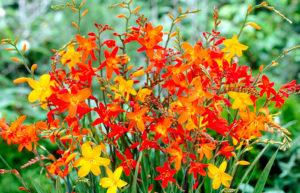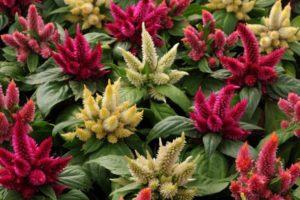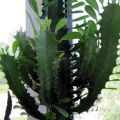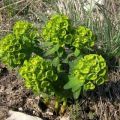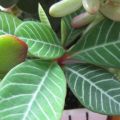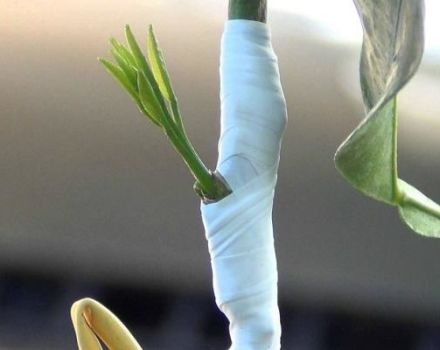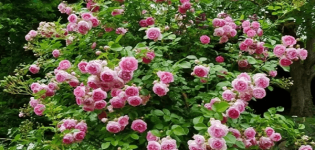Why milkweed leaves can turn yellow and fall off, what to do for treatment
Euphorbia (as the decorative flower is scientifically called) is a modest, unassuming plant. But some growers, especially beginners, do not take into account the individual nuances of growing and care, and then wonder why the milkweed's leaves suddenly turn yellow and fall off.
Causes of foliage problems and what to do about it
Although the flower is not too capricious, this does not mean that there is no need to care for it. The main condition for growing indoor milkweed is location. From direct sunlight, the leaves of euphorbia can get burned, which means that the shadow side is more suitable. Drafts are just as dangerous as cold temperatures. Euphorbia is a heat-loving flower.
If the leaves turn yellow and fall off
It happens that the leaves of the plant turn yellow and fall off. Illness can cause yellowing.
By autumn, the spurge grows more slowly, and begins to prepare for winter. During this period, the leaves turn yellow. Do not be afraid, since this is a normal natural phenomenon. The flower will relax, calm down, and by spring the young foliage will become even more magnificent. For euphorbia, the fall of the lower old leaves is characteristic, and the new ones grow higher. But this is also not a cause for concern.

Drops the leaves
It happens that a flower sheds its foliage long before preparing for winter. This is a distress signal.
Sometimes a stressful condition can cause yellowing and falling leaves:
- lack of fertilizers;
- lack of light;
- the presence of drafts, cold snap;
- improper watering.
If these factors are excluded, nevertheless, sometimes it happens: the leaves wither, fall, obviously, the problem is serious.
The stem and leaves wither
Euphorbia for a short time consumes a lot of useful raw materials from the ground, and then lacks nutrients, which can cause the stem to wilt, yellow leaves.
The flower needs constant nutrition. He needs to be fed more often, at least twice a month, especially in winter.
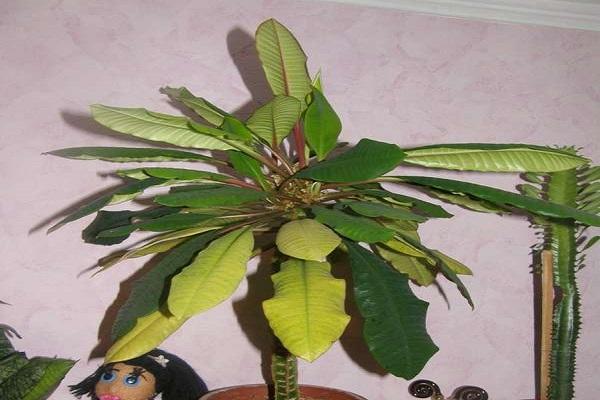
The angle of inclination of the leaves has changed
If you take care of the milkweed incorrectly, its leaves will droop, the leaves will bend. This means that the problem lies in the roots of the plant, they have rotted from excess moisture. To preserve euphorbia, it is transplanted:
- They carefully take it out of the pot, examine it, cut off the rotten roots with a knife.
- The cut sites are powdered with activated carbon.
- At the same time, one should not forget about the drainage from expanded clay or crushed stone.
- They plant euphorbia in a new pot with a different soil.
When working with a plant, you must be careful, remember that the milk of the flower is poisonous. In contact with the skin, it can cause severe burns, irritation, an allergic reaction.
In winter, euphorbia is not watered as often as in summer. After winter, the plant needs more moisture, increased watering is resumed.
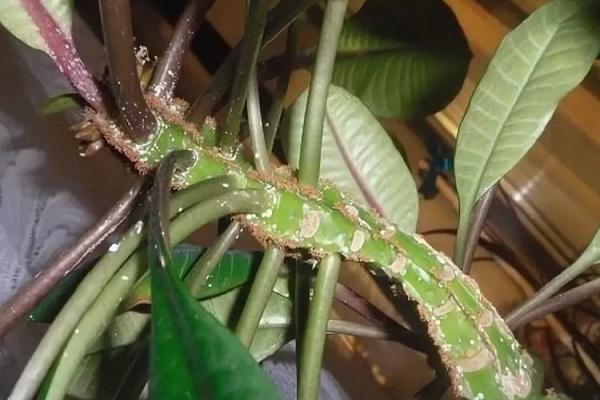
What diseases and pests adversely affect the condition of the leaves
If all the conditions for keeping milkweed, caring for it are met, and the flower still withers, withers, turns yellow, falls off, it means that it is sick. Fungal and viral diseases can cause this condition.
Root and stem rot
The disease is noticeable by black dents on the stem. They appear slightly above ground level, grow, spread along the stem. Later they get inside and destroy plant tissues. The stem breaks, the flower dies.
The following circumstances could lead to decay:
- overfeeding with nitrogen;
- frequent watering;
- high air temperature;
- lack of light;
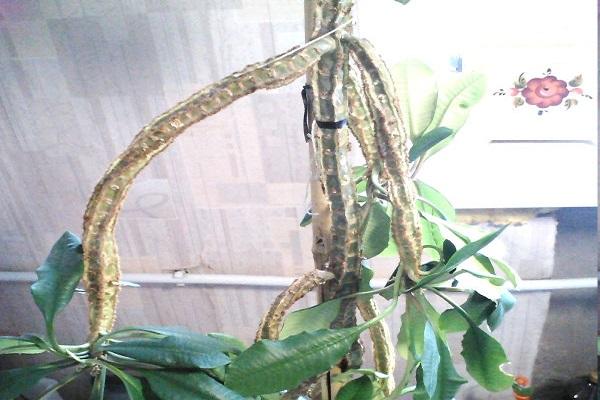
For the treatment of euphorbia in the early stages of the disease, systemic fungicides are used (Ridomil, Previkur). They stop watering the flower, change the nutrient medium.
Gray rot
The causative agent of the disease is a fungus. Brown spots appear on the leaves of the plant, as if rotten. The spots grow and cover the entire leaf. The increased humidity of the air accelerates the development of the fungus, which is why the pathogen does not leave a healthy space on the leaves, they turn gray.
The plant becomes infected through soil, water. The fungus lives in this environment for a long time. Circumstances complementing the threat of the disease:
- oversaturated air;
- insufficient ventilation of the room;
- excess nitrogen in the earth.
Fungal disease is treated with systemic fungicides (Bona Forte, Bravo, and others). As a preventive measure, in order to avoid illness, it is necessary to monitor the humidity of the air, plant the plant in disinfected soft soil.
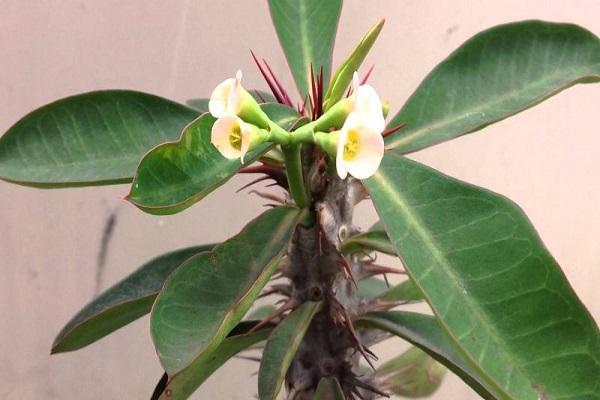
Rust
The surface of the leaves is covered with brown, as if rusty, oval-shaped layers. Then they join and form rusty ribbons. Usually mushrooms appear on the inside of the leaves, may be on petioles. Occasionally, red ribbons appear on the stalk of the milkweed.
If the flower is not treated, it will die. Fungicides will help save spurge. Proper watering and spraying will prevent the appearance of rust.
Alternaria
Fungal disease is manifested by the appearance of large dark spots on the foliage of euphorbia. Most often they infect emaciated aged leaves. Excess humidity, too warm air intensify the development of a fungal infection. The source of the disease may be soil in which live pathogens have been preserved.
"Skor", "Ridomil Gold" are systemic fungicides that will cure the fungus if it has managed to hit the flower. As a preventive measure, biological fungicides are used ("Fitosporin", "Baktofit" and others).
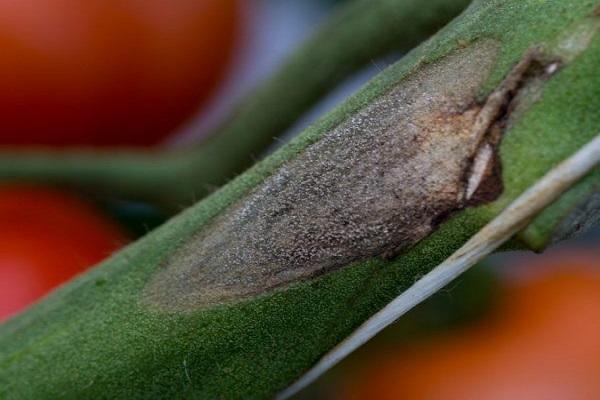
Bacteriosis
With this disease, spurge grows poorly, develops, does not bloom. The foliage and the stem are covered with brown, rusty spots. Strange discharge with an unpleasant odor follows from the stains. Excess moisture, nitrogen in the soil contributes to the early development of the disease.
Milkweed is handled with care, because it is through mechanical damage that the infection enters the plant.
Powdery mildew
Fungal disease. On the leaves appear foci with a fluffy dark gray bloom. Before this, the foliage dries up. The disease is contagious, the infection is carried by the wind. Too hot weather, dryness, lack of moisture in the soil aggravate the situation. Proper care of milkweed will help prevent illness. If the flower is sick, they are treated with antifungal drugs ("Topaz", "Fundazol").
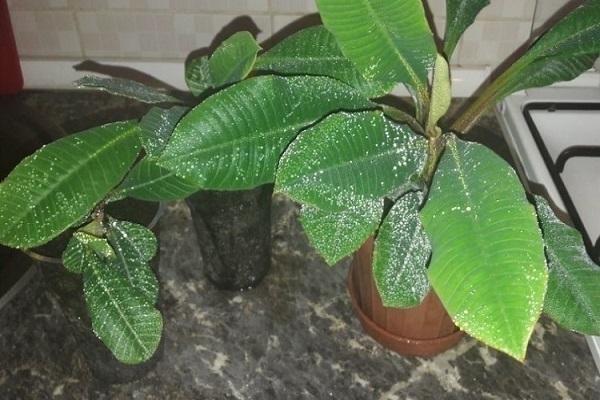
Tobacco mosaic
The causative agent of the disease is a virus. The infection is most often carried by whiteflies. Sick leaves are deformed.Spots appear on the leaf plate: white, yellow and even reddish. As a preventive measure, they are treated with insecticides. Infected cuttings can be the source of the disease. Planting healthy cuttings will eliminate the tobacco mosaic.
Red spider mite
A half-millimeter spider mite eats up young milkweed foliage. It is small enough to see the harmful insect with the naked eye. The appearance of white, yellow spots on the leaves of the plant indicates the presence of a tick. Infected seedlings are separated from healthy ones, poured over them with a solution of laundry soap, which is rubbed on a fine grater.
From the tick, the plant is treated with acaricides, for example, "Aktara".At the first sign of a tick, urgent action is taken as insects spread quickly.
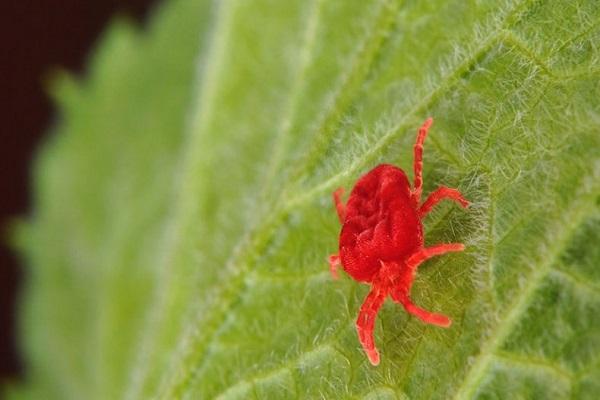
Aphid
Symptoms of the disease are manifested in a change in the shape of milkweed leaves, they curl, look underdeveloped, ugly. Then they begin to turn yellow and fall off. In some areas, color disappears. The plant stops growing and developing.
Sometimes yellow and light green insects are collected by hand, they can be seen with the naked eye. Branches with large lesions are removed. The flower is processed with "Fitoverm", "Aktellik", "Decis".

Root mealybug
The parasites infect the milkweed root system. They are collected on the roots of the plant in colonies in the form of scattered flour. With severe infestation, pests are visible.
The plant stops growing and developing. Milkweed leaves turn yellow, dry out, and fall off.
At the first signs of the appearance of insects, in order to save the euphorbia, it is dug up by the roots, freed clean from the soil, and treated with insecticides. The dish from under the flower is disinfected, fresh earth is poured. Before planting, the roots are carefully examined for any parasites.

Whitefly
Accumulations of insect larvae can be observed from the inner underside of the milkweed leaves. They live by feeding on the sap of plant cells. They appear as yellow and white markings. The leaves of the plant roll up, change the green color to yellow, die off.
Whitefly offspring are greenish, and the adult parasite is white. The midge is easy to see. Heavily infected areas are removed, and the spurge is treated with insecticides at least 1 time in three days.

Mosquitoes on milkweed
The mosquitoes themselves are not dangerous to the flower. But they leave their larvae on the plant, which will feed on milkweed. The offspring of mosquitoes, although small (larvae 0.5 cm), poses a serious threat to young seedlings. Sick seedlings are separated from healthy ones. As a preventive measure, the soil is treated with insecticides. To get rid of mosquitoes, sticky tapes are hung.
The causes of yellowing, leaf death lie in improper care. Subject to all the recommendations of flower growers, the threat of infection is minimal. In order for the euphorbia to be healthy, to please with flowering, it is necessary to regularly inspect the plant and take measures in time.
